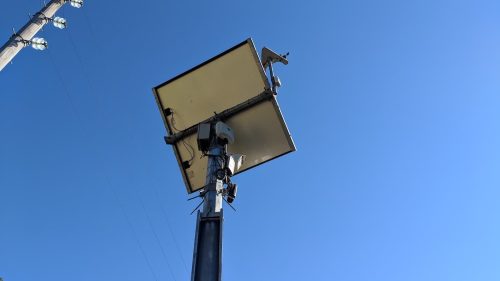A solar light on pole system is a smart, self-contained way to illuminate outdoor spaces using sunlight. These systems combine a solar panel, battery, light fitting, and a support pole to deliver lighting without the need for underground wiring or mains power. From bush tracks and car parks to streets and remote communities, solar lighting poles are already popular in Australia and are continuing to grow.
Australia’s climate, with its long sunny days and growing demand for sustainable infrastructure, makes it an ideal environment for solar lighting. But what exactly goes into a solar pole system, and why are they becoming such a popular choice?
How Solar Light Poles Work
The way solar light poles work is very simple, solar panels on the pole collect sunlight during the day and store that energy in a battery. As the sun goes down, the stored energy powers an LED light (or any other electronic device mounted to the pole), often controlled by a sensor or remote control to turn on at dusk and off at dawn.
Everything is mounted on a single light pole, which can be installed in a range of locations. Because the system doesn’t rely on grid power, it operates independently, which is especially useful in areas where electricity access is limited or costly to install.
Why They’re Gaining Popularity
There are a few reasons why solar poles have seen such strong uptake across public (parks, councils) and private sectors (hotels, private recreation areas) in recent years:
Cost-effective in the Long Run
While the initial setup might be more than a conventional light, the running costs are minimal. There’s no electricity bill, no trenching, and less infrastructure to maintain. In remote areas or temporary setups, the savings can be significant.
Easy to Install
With no need to connect to mains power, solar poles are quicker and simpler to install than wired alternatives. This means less disruption to existing infrastructure and faster project timelines.
Sustainable Lighting
Powered entirely by sunlight, these systems help reduce your carbon footprint and support a shift towards cleaner, more sustainable urban and regional development.
Adaptable to Different Environments
Whether you’re lighting a pathway, a car park, or a temporary site, solar poles can be customised to suit different light outputs, heights, and applications. Many are also built to withstand tough conditions, from high winds to extreme temperatures.
Where You’ll See Them
Solar lighting poles are being used in more and more places across Australia. Some common applications include:
- Walking trails and parklands
- Regional town centres and public amenities
- School or shopping centre car parks
- Roads and intersections in rural areas
- Temporary construction or event sites
- Coastal lookouts and tourist facilities
- Industrial and mining sites
What makes them so useful in these settings is that they’re self-sufficient meaning no matter how remote or off-grid the location, a pole for solar light can operate independently as long as it has clear access to the sun with little to no running costs.
What Makes up a Solar Light Pole?
While designs vary, most systems include:
- A solar panel, mounted on or near the top of the pole, angled for optimal sun exposure
- A battery, usually stored inside a secure enclosure
- A controller to regulate power between panel, battery, and light
- A high-efficiency LED (or whichever electronic device is mounted e.g. CCTV)
- A structural light pole that holds everything in place
Some models include extra features like remote control access, motion sensors, or the ability to adjust colour temperature depending on the location.
Things to Consider Before Installing
If you’re considering installing solar light poles, here are a few things to keep in mind:
- Sunlight Access: Solar panels need good exposure. If your site is heavily shaded or positioned in a valley, efficiency may drop.
- Battery Life and Maintenance: Most systems use lithium or sealed AGM batteries with lifespans of 5–10 years. Minimal maintenance is required, but it’s still something to factor in.
- Lighting Needs: How bright should the area be? How many hours should the lights run? Some systems run all night, others dim in off-peak hours.
- Local Conditions: Wind loading, vandalism risk, and local council requirements may influence the type of pole or mounting system you choose.
A Step Towards a Sustainable Future
As Australia works toward net-zero emissions and smarter city planning, solar infrastructure is playing a bigger role in how we build. Choosing a solar light on pole setup is one small step that contributes to a broader shift, helping to lower emissions, increasing resilience, and reducing long-term costs.
It’s not just about the environmental benefit either. In many cases, solar poles offer the most practical lighting solution for isolated or temporary sites where running power simply isn’t an option.
Need Further Information?
Now being informed about solar light poles, if you’re planning a project that requires a solar lighting pole, G&S is here to help. We can recommend the right solar panel pole for solar light setups, ensure compliance with relevant standards, and deliver solutions that are both functional and built to last.
We deliver across Australia, including Perth, Melbourne, Brisbane, Sydney, Darwin, and remote regional centres.
If you’re still unsure, get in contact with us today and our team will be able to assist you with your solar panel pole needs.
Frequently Asked Questions
Pole height depends on the lighting application. For pathways or parks, 4–6 metres is common. For street lighting, 8–12 metres may be required.
No. Solar light poles are standalone units that operate completely off-grid.
Most solar poles are designed to support a single light per unit, but you can install multiple units across a site.
Battery life depends on usage and type, but high-quality lithium or AGM batteries can last 5–10 years with minimal maintenance.
Yes. At G&S, we engineer poles to meet wind loading requirements for each project location.

